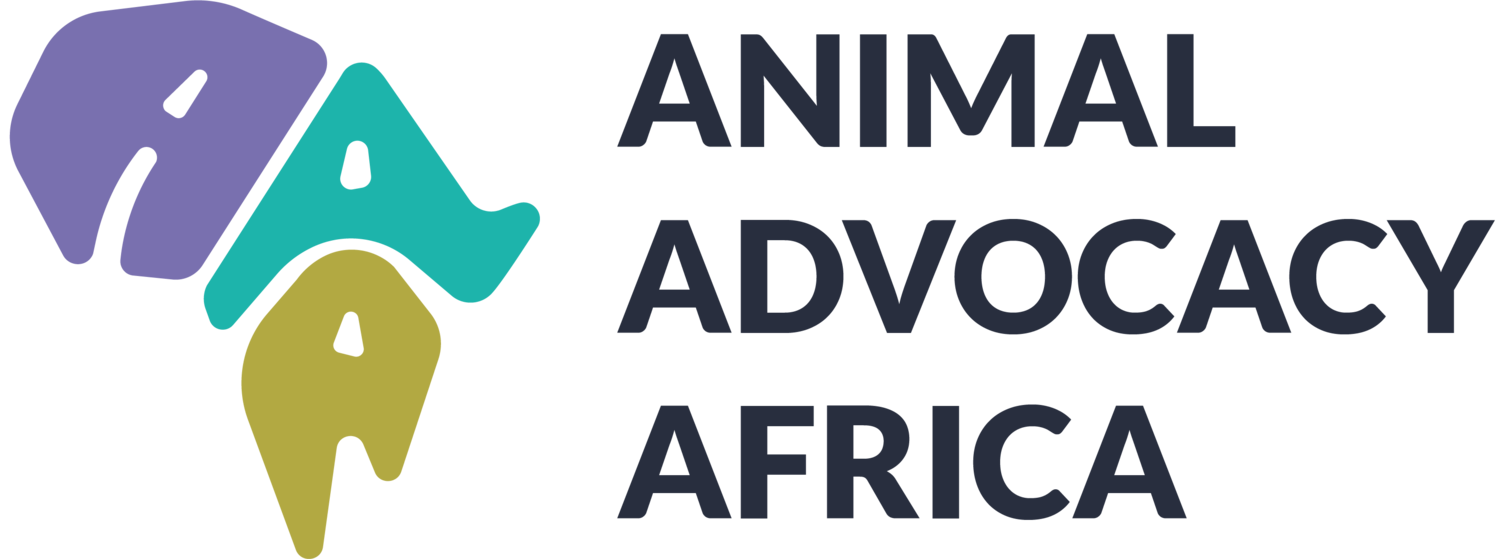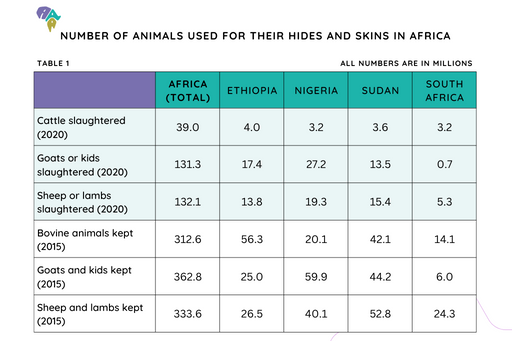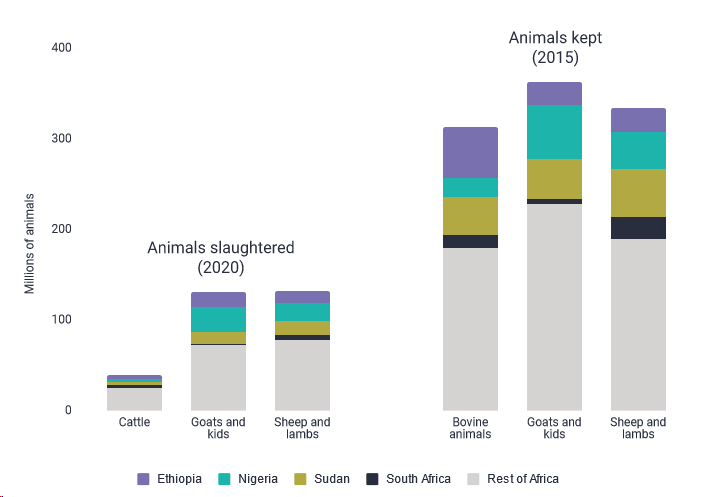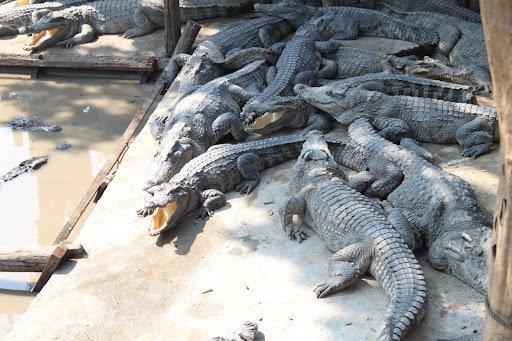What do we know about animals being farmed outside the food system?
Animal farming for the fashion industry and other non-food purposes in Africa
Author: Moritz Stumpe
The suffering caused to animals used for their hides and skins (such as in the fashion or leather industry) might be an underexplored area within the Effective Animal Advocacy community, as focus is usually put on the use of animals for food production. This area was more concretely brought to our attention when FOUR PAWS South Africa wrote a potential blog post for our website, highlighting the animal suffering caused by South Africa’s fashion industry. To understand more about this issue, we did a shallow analysis and ran the numbers. We find that work to help animals farmed for their skins and hides can be worthwhile compared to other animal groups such as companion or working animals, but also conclude that animals farmed for food production should remain our top priority. Below, we first present our detailed findings from this analysis, exploring the importance of the topic, and then feature FOUR PAWS’ blog post, focusing on specific issues in South Africa.
AAA’s Research and Cause Prioritisation
The Food and Agriculture Organization of the United Nations (FAO) publishes comprehensive data on the number of animals slaughtered for their hides and skins (including wool, leather, etc.) across the world. According to their database FAOSTAT, roughly 300 million animals were killed for their hides and skins in Africa in 2020. The majority were goats and sheep (~260 million) and the leading countries were Nigeria (~50 million), Ethiopia (~35 million), and Sudan (~33 million). South Africa, the focus of the blog post below, was in eighth place, slaughtering ~9 million animals for their hides and skins in 2020. Table 1 below provides an overview and detailed figures can be found in our spreadsheet.
In 2016, the FAO also published a report on raw hides and skins, leather and leather products, showing that roughly 1 billion animals were kept for use of their hides and skins in Africa in 2015. Across Africa, these numbers had steadily increased since 2005. While we did not do an in-depth analysis of this data, it seems that the number of animals farmed for their hides and skins is increasing in developing countries, while it is stagnating or even decreasing in developed countries - a pattern that seems similar to food production (see below for the interrelatedness of these two farming purposes). The FAO report also shows that the number of animals kept alive is even higher than the number of animals slaughtered per year, which is likely due to the fact that the animals analysed here typically have a longer life-cycle compared to other, smaller farmed animals like chicken. Similar to the slaughter statistics, leading countries in animals kept are Sudan (~139 million animals), Nigeria (~120 million), and Ethiopia (~108 million). In South Africa, ~44 million bovine animals, goats, and sheep were kept for use of their hides and skins in 2015. Detailed numbers for 2015 are also shown in Table 1. For better visualisation, we also include a graph illustrating the figures shown in Table 1.
Please note that the FAO numbers cited above only include sheep, goats, and bovine animals like cattle and buffaloes. It does not cover other animals that are also farmed for their hides and skins, like ostriches and crocodiles, which are included in FOUR PAWS’ blog post below. However, the numbers given by the FAO should cover the most widely used animals and should thus give a good estimate of the magnitude of the issue. Compared to other animal issues, the scope of this problem appears large. For reference, in our prioritisation report, we estimated the number of live companion and stray animals in Africa to be in the low hundred million and the number of working animals to be somewhere around 35 million.
These numbers also show that the use of animals for their hides and skins makes up a significant proportion of farmed animals in Africa. In 2020, there were ~3.6 billion live land farmed animals in Africa, including both animals raised for food as well as for their hides and skins (and potentially other purposes). Based on this number and the above estimate of ~1 billion animals kept for their hides and skins in 2015, we can estimate that roughly one quarter of all animals farmed in Africa are farmed for their hides and skins - among other purposes (see below). The number of farmed land animals slaughtered for food in Africa in 2018 was at ~4.6 billion, substantially higher than the above-indicated 300 million animals slaughtered for their hides and skins in 2020, suggesting that food production is the major contributing factor for animal slaughter in Africa. The higher number of slaughtered animals compared to live animals in food production is mostly a result of the large number of chickens, who have a much shorter lifespan than most of the other land animals in scope.
It is important to highlight at this point that many animals can be used for multiple purposes. A dairy cow could be used for milk production during her lifetime, while her skin is used for leather production after she has been slaughtered, or a sheep can be used for both wool and cheese production. We did not spend a lot of effort on evaluating these different uses and potentially disentangling the impact that each of them has on animal suffering, as this would require a much larger research effort. However, a strong argument can be made that hides and skins are increasingly becoming a non-valuable byproduct of meat and dairy production. While hides and skins have historically been a valuable part of an animal, the situation is shifting, as demand for meat and dairy products has increased and is still growing, while demand for leather products is on a downward trajectory on a global level. With skins and hides from the meat and dairy industries in abundant supply, the commercial case for raising and killing animals for their hides and skins can become very weak in many industries. Despite this primacy of food production as a factor in driving animal farming, there are animal groups, like ostriches (see the blog post featured below), that are farmed primarily for their hides and skins. In general, the balance of food vs. hides and skins as the most important economic factor for farming probably varies substantially between animal groups. While for most animals (e.g, chicken and cows), the majority of their economic value should lie in food production, the picture is less clear for others (e.g., sheep or goats), and some animals (e.g., ostriches) are even farmed primarily for their hides and skins.
This leads us to the conclusion that an emphasis on animals farmed for food production is warranted, if we want to have the largest positive impact on the lives of animals. However, as the production of skins and hides is interrelated with food production and involves the farming of roughly one billion animals across Africa, we do not want to categorically exclude this topic from our work and wider discussions on farmed animal welfare in Africa - especially when considering industries or animal groups where hides and skins are the main driving factor for intensive farming. We assume that projects to help animals farmed for their skins and hides can be worthwhile compared to other animal groups such as companion or working animals, while animals farmed for food production should remain our top priority.
With this context in mind, below is a guest blog contribution by FOUR PAWS South Africa, explaining their work towards reducing animal suffering in the fashion industry. We would like to thank FOUR PAWS for highlighting this issue and causing us to think more deeply about our own prioritisation of animal groups.
Workers in contact with toxic chemicals during the process of animal skin tanning ©Collective Fashion Justice.
FOUR PAWS South Africa Guest Contribution
Cruelty-Free Fashion: A Plea to South Africa’s Fashion Industry
Author: Bertha Moteane, FOUR PAWS in South Africa
Together we can drive an animal-friendly fashion future, and create a world where people treat animals with respect, empathy, and understanding.
Millions of animals around the world suffer in the world of fashion every year. FOUR PAWS in South Africa is embarking on a brand engagement drive to support a cruelty-free fashion programme, challenge the mistreatment of animals, and make animal protection an essential part of ethical fashion.
The FOUR PAWS Wear It Kind programme is an initiative designed to support and catalyse more compassion in the fashion industry. The programme works to ensure that an excellent level of animal welfare is provided to animals used within fibre supply chains, while encouraging a transition to more sustainable animal-free materials. Focus is placed on encouraging brands to be transparent and accountable, which in turn leads to positive change. We provide value, support, and are a critical friend to the fashion industry.
“We believe that highlighting good and bad practices, encouraging the development of robust certification initiatives, and mobilising consumers are all important components of achieving change. These are the tools that enable a world of animal-friendly fashion to become a reality.”
– Jessica Medcalf, Corporate Engagement Manager, Farm Animals & Nutrition, FOUR PAWS
While harmful practices that enable the use of animal-derived fashion are found across the world, there are several industries that are especially significant to South Africa.
Angora goat on a farm ©FOUR PAWS
Mohair
Mohair is one of South Africa’s largest produced fashion fibres, making up 50% of the world’s mohair production (World Atlas, 2017). The preferred breed for South Africa’s mohair industry is the Angora goat with two centuries of refinement by the South African mohair industry behind it (The Mohair Empowerment Trust). Mohair is South Africa’s sixth largest agricultural commodity export, comprising 4% of the total agricultural exports (Trade Probe, 2021). However, this long, smooth fibre commonly used in the production of warm fluffy clothing for winter items like sweaters, scarves, and hats can come at a very high cost, because the welfare of the goats used in production is not assured. These goats are often rushed through shearing processes which are often stressful on the animals. They are often subjected to painful mutilations without any anaesthetic and de-horned using hot iron or caustic chemical paste when just one or two weeks of age. Goats are also particularly vulnerable to developing pneumonia when sheared in cold and wet conditions and can die as a result.
Ostriches in a farm behind fenced cages ©FOUR PAWS
Ostrich Leather
Ostrich farming for leather production is another leading industry of farmed animals used in textile production in South Africa. Many researchers have labelled this industry as lacking transparency, with very little information on ostrich leather production reaching the fashion consumer. South Africa is the leading supplier of ostrich products to the world and produces approximately 70% of all ostrich meat, leather, and feathers on the world market (South African Society for Animal Science, 2011), providing skins to top fashion brands such as Prada and Hermes (PETA, 2017). Some of the cruelty reported from the ostrich slaughterhouses include feather plucking while still conscious, ostriches being kept in small and confined spaces, hung upside down, and electrocuted, as well as farm workers also being injured from dealing with distressed birds. A series of bird flu outbreaks have also been reported to have affected both the birds and the farm workers. South Africa’s ostrich farming crisis is therefore a catastrophe both for the low-skilled and vulnerable front-line workforce and the ostriches (Equal Times, 2016).
Crocodiles in confined concrete pits ©FOUR PAWS
Crocodile Leather
South Africa is the leader of crocodile skin production on the continent, with the region of South Africa, Zimbabwe, and Zambia exporting over 250 000 skins each year (Small Stater, 2015). The Nile crocodile, the only crocodilian species that occurs naturally in South Africa, is the most commonly used species in this production. Only 10% of the skins manufactured in South Africa are also sold within the country, while 90% are absorbed by fashion houses in Europe and Japan, and lower grade skins ending up in the Far East (Farmers Weekly 2012).
Thousands of Nile crocodiles are bred, intensively reared, and killed for their skins, often confined in concrete pits from birth to slaughter, deprived of the opportunity to engage in natural behaviours such as digging tunnels, playing, and protecting their young as they would in nature. In their natural habitats, Nile crocodiles can live up to 80 years, but in these farms, they are slaughtered at around the age of 3, and it takes two or three crocodiles to make just one handbag (PETA, 2015).
Like the ostrich leather industry, the crocodile skin industry also has negative bearings on its frontline workers, with many adverse health impacts arising from exposure to toxic chemicals used in tanning skins. These side-effects include cancer, respiratory, skin and eye problems from the chromium used in tanning and processing skins (The Pomelade, 2021)
Another concerning factor with the crocodile skin industry is a revelation made in Farmers Weekly (2012) that farmers feed their crocodiles chickens that had died on chicken farms, revealing the dependency of the industry on the intensive and often cruel caged chicken farming.
Many fashion consumers wear leather on the grounds that it is a by-product of animal slaughtering for meat production, while some believe it is a form of recycling to avoid waste and pollution, but this is not the case with these products, which are often the primary income generators for these industries. Overall, the fashion industry has a big impact on the lives of the farm animals from which materials such as wool, mohair, and leather are derived. Pushing for more transparency and getting brands and their supply chains to be more conscious can improve the lives of these farmed animals and shift the industry towards excluding animal-derived materials due to cruel practices and keeping conditions.
FOUR PAWS has a long history of campaigning for the welfare of animals used by the fashion industry. For over 30 years, we have been taking action for animals, starting with the fur industry. Today, FOUR PAWS has extended beyond fur and now also works across several textiles, including mohair, wool and leather. We are calling on the South African fashion industry to end the cruel practices and avoid products that derive from them. This includes the ending of the sale of real animal fur and exotic animal skins as well as other animal products such as wool and mohair. We further call on the fashion industry to ensure that alternatives to animal products are available to consumers and to develop and publish transparent animal welfare policies. Shoppers care about animal welfare. In order to enable shoppers to buy in line with their values, brands need to build animal welfare policies which put animal welfare at the centre of sourcing decisions and finally ensure that animal products are accurately labelled, advertised, and otherwise marketed so that consumers can make conscious and informed decisions.
FOUR PAWS is a global animal welfare organisation for animals under direct human influence, which reveals suffering, rescues and protects animals in need, and advocates for a world where humans treat animals with respect, empathy, and understanding.








